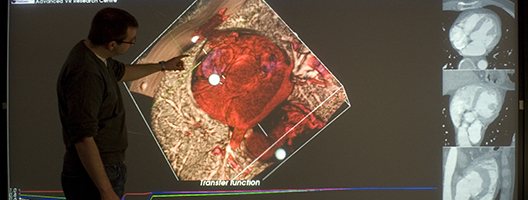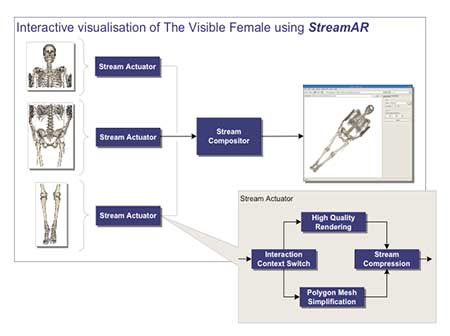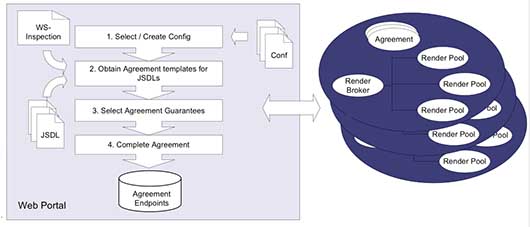Modelling and Simulation

Distributed Visualization Rendering for Grid Environments Through Stream Adaptat
Background
Large scale scientific visualisations continue to increase in both size and complexity, staying in line with advances in visualisation hardware. This means that tomorrows large scale visualisations will only be possible through the use of large scale or aggregated hardware resources. An effective system through which these systems can be remotely harnessed is essential if the scientific community is to continue a process of detachment from hardware resources, as achieved by remote steering frameworks for computational science. Such a system is being developed at the Advanced VR Research Centre (AVRRC) as part of an EPSRC PhD studentship.
There are two main focuses of this research. The first is to develop a technology capable of delivering interactive access that will meet the changing demands of researchers. The second focus is to make this technology accessible to the scientific communities. In essence, this means that accessing a large scale visualisation should be no more difficult than other on-line media such as Internet video streaming.
Scope
From the outset, the project has focused on providing remote interactive access for existing visualisation applications, rather than imposing a new visualisation environment on application scientists. This direction was adopted as result of a study of visualisation applications used by scientists carried out by AVRRC, which noted that scientists often preferred their own in house applications to more general visualisation environments.
This constraint has led to an innovative solution capable of delivering user focused high performance visualisations for a wide variety of visualisation domains from material science to stereoscopic CT and MRI visualisations.
Research Activities
The broad scope of this research project incorporates many different research domains including human computer interaction, adaptive control mechanisms, heterogeneous resource co-operation and management protocols, and service level agreements.
The critical problem of developing an adaptable distributed rendering system has been tackled by analysing other Internet streaming domains and various visualisation techniques. In particular this research examined:
- Level-of-detail rendering techniques
- Image compression techniques
- OpenGL streaming
- Network transport protocols
- XML user interfaces
Research Output
The project has resulted in a number of advances in the field of remote visualisation:
Adaptive distributed stream rendering
A control framework has been developed that automatically adapts a distributed rendering system to changes in resource and visualisation performance, delivering responsive user orientated visualisations. The framework operates at the graphics library level, providing transparent support for most existing visualisation applications.
Effective remote user interaction
New methods for providing consistent, low latency user interaction have been developed. This has been achieved through the use of multiple asynchronous interaction loops, which can be transparently applied to existing visualisations (Figure 1). GUI interaction is provided through a local desktop interface that is automatically customised to match the application, providing local GUI interaction without coupling the local application to a specific visualisation.

Figure 1 Local and remote interaction loops
Service Level Agreements for distributed rendering
An intuitive system that provides users with service level agreements on distributed rendering has been developed. The system complements the new interaction and rendering technology to provide the user with a tool through which distributed visualisation can be initiated, controlled and monitored. The user is presented with a convenient method to express visualisation requirements and goals. The system achieves cross platform interoperability using standards based web service components, exploiting the new WS-Agreement and the job submission description language (JSDL). Agreement monitoring and resource migration has been incorporated into the application user interface (Figure 2).

Figure 2. Agreement monitoring with the unique web browser based visualisation interface.
A number of publications have been produced as result of this work, including:
O'Brien J. T., Kalawsky R. S. "A novel control mechanism for distributed stream rendering". In Proceedings of the Theory and Practice of Computer Graphics (TPCG'07), June 2007, pp. 139 - 146. ISBN 978-3-905673-63-0
O'Brien J. T., Kalawsky R. S. "A service Agreement Framework for Grid based Distributed Rendering" In Proceedings of 6th UK e-Science All Hands Meeting (2007).
Project Consortium
This project is funded by EPSRC (http://www.epsrc.ac.uk).
EP/C536452/1 Platform: RealityGrid Platform Grant
GR/R67699/02 The RealityGrid - a tool for investigating condensed matter & materials
GR/R67699/01 The RealityGrid - a tool for investigating condensed matter & materials
The research project was initially carried out as part of the UK e-Science RealityGrid program. RealityGrid represents a consortium of UK universities, bringing together both application scientists in areas as diverse as condensed matter systems and life sciences, along side computational scientists.
Our research partners:
 |
 |
|
 |
